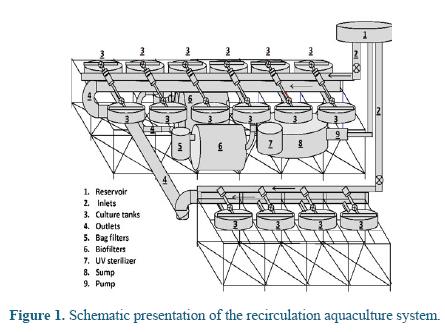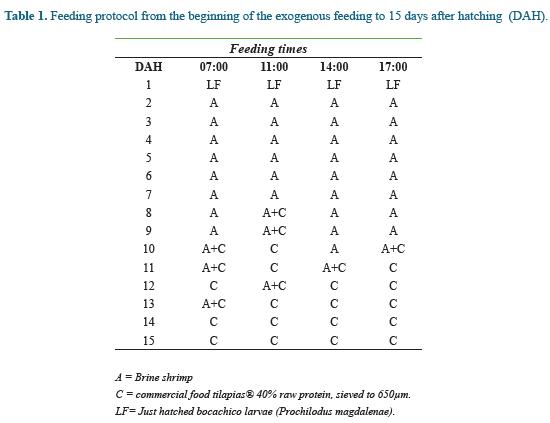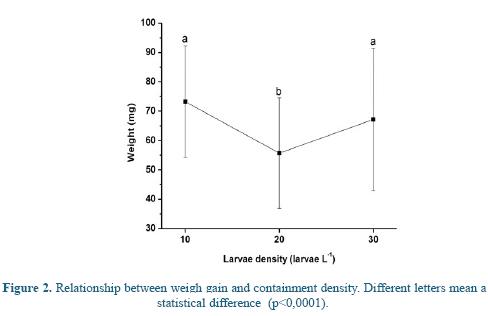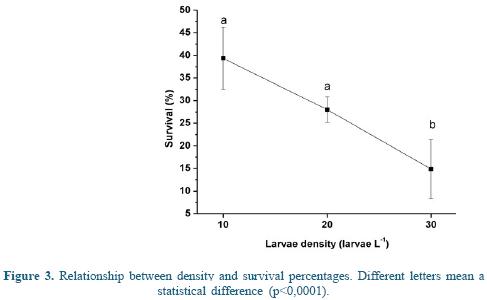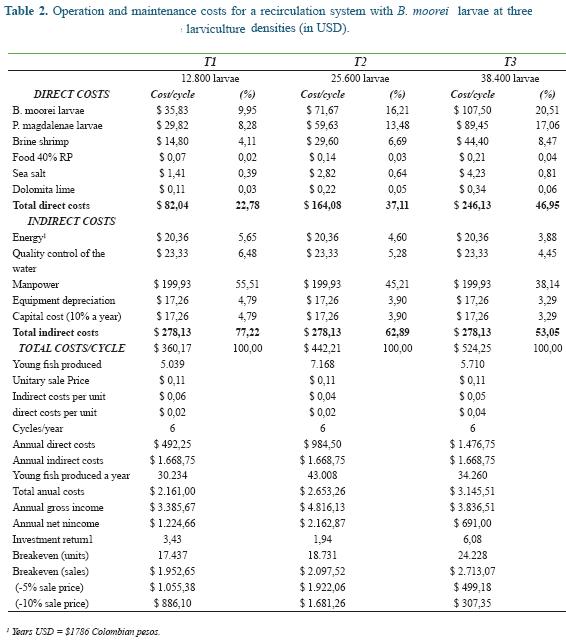Services on Demand
Journal
Article
Indicators
-
 Cited by SciELO
Cited by SciELO -
 Access statistics
Access statistics
Related links
-
 Cited by Google
Cited by Google -
 Similars in
SciELO
Similars in
SciELO -
 Similars in Google
Similars in Google
Share
CES Medicina Veterinaria y Zootecnia
On-line version ISSN 1900-9607
Ces. Med. Vet. Zootec. vol.9 no.2 Medellín July/Dec. 2014
Evaluation of a recirculation system for Dorada (Brycon moorei-Steindachner 1878) larvae in the Magdalena River¤
Evaluación de un sistema de recirculación para la etapa de larvicultura de dorada (Brycon moorei-Steindachner 1878) del Río Magdalena
Avaliação de um sistema de recirculação para a fase de larvicultura de dourada (Brycon moorei-Steindachner 1878) de Rio Magdalenao
Carlos Arturo David Ruales1*, *, Biol, Esp, MSc; Germán David Castañeda Álvarez2, Zoot, Esp, MSc.
¤Para citar este artículo: David Ruales CA, Castañeda Álvarez GD. Evaluation of a recirculation system for larviculture stage of dorada (Brycon moorei-Steindachner 1878) from the Magdalena River Basin. Rev CES Med Zootec. 2014; Vol 9(2): 179-189.
*Autor para correspondencia: Carlos Arturo David Ruales. Facultad de Ciencias Administrativas y Agropecuarias, Corporación Universitaria Lasallista, Carrera 51 118 sur-57, Caldas-Antioquia, Colombia.
E-mail: cadavid@lasallistadocentes.edu.co
1 Grupo de Investigación en Producción, Desarrollo y Transformación Agropecuaria, Profesor, Programa de Zootecnia, Facultad de Ciencias Administrativas y Agropecuarias, Corporación Universitaria Lasallista. Caldas-Antioquia, Colombia
2Investigador asociado, Gerente Técnico Piscícola Doradal
(Recibido: 2 de mayo, 2014; aceptado: 31 de octubre, 2014)
Abstract
Recirculating aquaculture systems allow increased productivity during larval stages due to a greater control of water quality parameters. Dorada larvae (Brycon moorei) were used 12 hours post hatching (HPE) to evaluate three planting densities with four replicates per treatment and 10, 20 and 30 larvae L-1 (T1, T2 and T3, respectively). The larvae were fed with Bocachico (Prochilodus magdalenae) larvae, Artemia salina nauplii and a 40% crude protein (CP) commercial diet for 15 days. Results showed significant differences between treatments (p<0.0001) for weight gain and specific growth rate (TCE), where T1 performed better (73.24±19 mg and 14.21±5.02%, respectively); followed by T3 (67.15±24.3 mg and 13.94±7.51%) and T2 (55.67±18.33 mg and 13.36±5.75%). Survival rate was inversely related to density, with highly significant difference (p <0.0001) (39.37±6.84%, 28.00±2.80% and 14.87±6.47%) for T1, T2 and T3, respectively. Simultaneously, cannibalism was directly related to planting density. The highest profitability was obtained with T2.
Key words: Brycon moorei, density, larval rearing, recirculation survival.
Resumen
Los sistemas con recirculación para acuicultura permiten el incremento de la productividad en la etapa de larvicultura, debido al mayor control de los parámetros de calidad de agua. Larvas de dorada (Brycon moorei) de 12 horas post eclosión (HPE) fueron utilizadas para evaluar tres densidades de siembra con cuatro replicas por tratamiento, 10, 20 y 30 larvas L-1 (T1, T2 y T3, respectivamente). Las larvas fueron alimentadas durante 15 días, con larvas de bocachico (Prochilodus magdalenae), nauplios de Artemia salina y una dieta comercial de 40% de proteína cruda (PC). Al final del experimento, los resultados muestran diferencias altamente significativas entre los tratamientos (p<0.0001) para ganacia de peso y tasa de crecimento específica (TCE), obteniendo un major desempeñoen T1 (73,24±19 mg y 14,21±5,02%, respectivamente); seguido por T3 (67,15±24,3 mg y 13,94±7,51%) y T2 (55,67±18,33 mg y 13,36±5,75%). La sobrevicencia se relacionó de manera inversa con la densidad con diferencia altamente significativa (p<0.0001) (39,37±6,84%; 28,00±2,80% y 14,87±6,47%) para T1, T2 y T3, respectivamente y, simultáneamente, el canibalismo fue directamente relacionado con la densidad de siembra. Por otro lado, la mayor rentabilidad fue obtenida con T2.
Palabras clave: Brycon moorei, densidad, larvicultura, recirculación, sobrevivencia.
Resumo
Os sistemas de recirculação de aquicultura permitir o aumento da produtividade na fase de larvicultura devido ao melhor controle dos parâmetros de qualidade da água. Larvas Bream (Brycon moorei) 12 horas após a eclosão (HPE) foram utilizados para avaliar três densidades de estocagem, com quatro repetições por tratamento, 10, 20 e 30 larvas L-1 (T1, T2 e T3, respectivamente). As larvas foram alimentadas durante 15 dias com bocachico larvas (Prochilodus magdalenae), náuplios Artemia salina e uma dieta comercial de proteína bruta de 40% (CP). No final da experiência, os resultados mostraram diferenças altamente significativas entre tratamentos (p < 0,0001) para o ganho de peso e taxa específica de crecimento (TEC), obtendo-se um grande desempeño en T1 (73,24±14,21 mg e 19±5,02%, respectivamente); seguido de T3 (67,15±24,3 mg e 13,94±7,51%) e T2 (55,67±18,33 mg e 13,36±5,75%). O sobrevicencia está inversamente relacionada com a densidade, com diferença altamente significativa (p<0,0001) (39,37±6,84%; 28,00%±2,80 e 14,87±6,47%) para T1 , T2 e T3, respectivamente e, simultaneamente, o canibalismo foi diretamente relacionada à densidade de estocagem. Por outro lado, o maior rendimento foi obtido com T2.
Palavras-chave: Brycon moorei, densidade, larvicultura, recirculação, sobrevivência.
Introduction
The Brycon genus includes more than 60 species of fresh water fish, and can be found distributed in Central and South America16. Doradas, as representatives of such group, are stenohaline and important species as commercial fish in the Magdalena and Sinú rivers, in Colombia. They have been reproduced by decades, by the action of researchers and aquaculturers, because of their size, rapid growth, omnivorous feeding22, acceptance of artificial food, from both vegetal and animal origins, a culture of consumption of their meat and their character as excellent sport fish4,5,23. There are, nevertheless, evidences of the fact that this fish group is in high jeopardy20. Regarding the fact that most of the Colombian native fish have altricial or indirect development larvae, several authors say that the critical time and the success in the production of fingerlings is the start of the exogenous feeding. Given this fact, this stage requires a very special care1,4,15. Even though a number of environmental factors such as population density, shelters, clarity of the water, light intensity and feeding frequency, among others, are linked to the larval development, the availability and the quality of the food seem to be the most important factors to be regarded for larviculture activities11.
The use of recirculation systems in the larviculture stage has had, as a result, the industrialization of pisciculture in several countries, with species such as the Atlantic halibut, Hipoglossus hipoglossus29, the sea bass Dicentrarchus labrax25, the African catfish, Clarias gariepinus13, the Indian rohu, Labeo rohita28 and the tiger sorubim, Pseudoplatystoma corruscan21. This technological development has made possible an increase of the efficiency and the profitability of fish industries, with environmental sustainability as an added value, and the use of such techniques in the conservation of native species due to the re-population and the reduction of the capture pressure given by overfishing and by the environmental damage.
In Colombia, the information about larviculture in native species from warm waters in super intensive systems is scarce or inexistent. Therefore, the objective of this research work is to evaluate the larviculture stage of the Brycon moorei (Steindachner 1878), in a recirculation system, with three containment densities, and its effect on the growth and survival of the fish and on the profitability of the system.
Materials and methods
Aval Ethics Committee for animal experimentation
Act number 001 September 2012. The experiment is framed within the principles of animal welfare. Ethics Committee of the Corporación Universitaria Lasallista.
Location
The Research work was performed in the pisciculture station of Universidad de Antioquia, located in San José del Nus, San Roque, at 735 meters above the sea level and at an average temperature of 24 ˚C.
Biological Material
Two male individuals were chosen given their external maturity characteristics (1,56±0,23 kg) and a female (2,7 kg), to which an ovarian biopsy by cannulation was applied. A hormonal induction protocol was used. It was a modification of the hypophization protocol standardized by Woynarovich & Horvath30. The fertilization of the eggs was performed in a semi-natural way. They were collected and incubated in volumes of 2 L of hydrated egg per incubator (an up flow 60 L incubator was used, with a flow rate of 3,5 L min-1). The hatching percentage at 12 hours after the fertilization at 24,3±0,7 °C was registered at 84,3±1,7%. At the hatching time, the larvae weighed 0,76±0,8 mg. 12 hours after the hatching, the larvae were counted and randomly distributed into three treatments (10, 20 and 30 larvae L-1) with four replicas for each one, for 800, 1600 and 2400 larvae per container, respectively, until the 15th day after the hatching.
Characteristics and management of the recirculation system
The 2650 L recirculation system, explained in figure 1, was made with 16 circular plastic containers with an effective volume of 80 L. The filtration system for solid particles consisted of two bag filters of 60 L each, with a 25 µm mesh. They worked in parallel and discharged water into the biological filtration system, which consisted of two biofilters built in two plastic tanks, each one with 200 L of capacity. The water velocity was 18 mm s-1and the hydraulic retention time was 7,14 minutes. The tanks were connected to a 25 L min-1 UV sterilizer. The clean water was stored in a main reservoir of 500 L with magnetic level, united to an electric pump of 1,5 HP (320 L min-1) which drove the water to an elevated 250 L tank in which it was, again, distributed to the experimental tanks. The pipelines for the water distribution was made of 1,5” PVC. The water inlet pipe to drive the water to the culture tanks was made of 0,5” PVC, and the outlet pipe from the culture tanks was made of PVC 1”, carrying waste water to a PVC collection pipe of 3”, which ended in the filters for solid particles.
The flow used in the experimental units was 3,5 L min-1 and the hydraulic retention time was 22,85 min. The water used for the system came from an auxiliary de1/8 HP (25 L min-1) electric pump installed on the water collection channel of the pisciculture farm. 250 L of water were re-changed every day, which is equivalent to 9,43% of the total volume of the system, in order to keep the water´s quality.
Water quality
The physical and chemical characteristics of the recirculated water were registered every day, before the daily re-change, with the water quality kit for pisciculture1 and were kept within the following ratios: temperature, 26,2±0,9 ˚C; dissolved oxygen, 6,75±0,71 mg L-1; pH, 7,61±0,14; thickness, 70,54±6,05 mgL-1 CaCO3; alkalinity, 72,68±7,92 mg L-1 CaCO3, total ammonium, 0,36±0,1 mg L-1 and non-ionized ammonium, (NH3) 0,0114±0,006 mgL-1.
Feeding
The beginning of the exogenous feeding took place at 24 hours after hatching (HAH) at 25,3±0,6 °C and the feeding protocol used is shown in table 1.
Zootechnical parameters
Statistically representative samples of larvae from each treatment were taken, and a record of their weight at the beginning and at the end of the experiment was made by the use of an analytical balance2 (sensibility 0,01 mg). Weight gains (WG) and the specific growth rate (SGR) were calculated according to the formula SGR=100(Ln Pf - Ln Pi)/(fT-iT), (14) in which Pf and Pi are the initial and final weights. Tf and Ti is the time in days, fT=final time and iT =initial time27. Also, the survival for each replica was registered.
Economic analysis
In order to determine the economic feasibility of each treatment, the investment was evaluated with a discontinuous cash flow, time of return of the investment, breakeven and sensibility analysis, on the base of the initial investment and a cash flow period of 10 years. The breakeven was calculated by the use of the fixed expenses (including the depreciation of the machinery and the equipment, and the cost of the capital), price per sold unit (U$ 0,11) and the cost of each unit produced. The sensibility analysis was performed reducing the sale price of the fish (5% and 10% of reduction under it was calculated in the budget). As a complementary information, and very important for the cost structure, the management time of the system was determined, taking the maturity seasons of the reproducers as a base, which are usually between March and June.
Statistical analysis
The results were analyzed by the use of ANOVA with 95% of confidence. The Tukey test was used to separate the average effects at the same level of probability and a data transformation with arc-seno was performed for the survival analysis. The tests were performed with the statistic Statgraphics Centurión (XVI)® software, license supported by Corporación Universitaria Lasallista.
Results
The highest weight gain (WG) was registered for the treatment with the lowest density T1 (73,24±19 mg), followed by the one with the highest density T3 (67,15±24,3 mg), with no significant difference (p<0.0001). The lowest weight gain was registered in the intermediate density T2 (55,67±18,33 mg) with a highly significant difference (p<0.0001) if compared to T1 and T3 (Figure 2). Similarly, when the specific growth rate (SGR) was determined, the maximum daily growth value was registered for the least dense treatment T1 (14,21±5,02% day) followed by the one with the highest density T3 (13,94±7,51% day) with no significant difference (p<0.0001). The lowest SGR was registered in the intermediate density T2 (13,36±5,75% day) with statistical difference (p<0.0001) when compared with T1 and T3.
The biggest survival rate was obtained in the treatment with the lowest density T1 (39,37±6,84%) followed by the intermediate one T2 (28,00±2,80%) with no significant statistical difference (p<0.0001). The lowest survival was obtained with the highest density T3 (14,87±6,47%) with statistical difference (p<0.0001) if compared to T1 and T2 (Figure 3).
The data for the economic feasibility calculation of each density are shown in detail in table 2. It was determined that the highest proportion of the direct cost was food (12,83 - 26,44% for the different treatments), followed by the cost of the larvae (9,95 - 20,51%) and the highest percentage of the indirect costs was the manpower (55,51%). The direct costs per unit produced were found between U$ 0,02 and U$ 0,04, in a direct correlation with the density. The indirect costs per unit produced were calculated between U$ 0,04 and U$ 0,06, with the lowest value for the intermediate density and the highest value for the lowest density. The investment return time was longer for the highest density (3,43 years), and the shortest was that of the intermediate density, with 1,94 years. The lowest breakeven in annual units produced was for the highest density (17.437 units), followed by the intermediate one (18.731 units) and the highest in the highest density (24.228 units).
The sensibility analysis showed a higher impact for the highest density, which means that a 5% reduction in the price would reduce the net annual income in 27,76%, while the same calculation for the lowest density was 13,82%. The intermediate density was the least affected (11,13%).
Discusión
The physical-chemical properties of the water during the experiment, in a general way, did not have great variations and are considered as normal or acceptable to cultivate fish of this genus6,24.
According to several authors, the species of the Brycon genus have a cannibal behavior from the moment the exogenous feeding begins2,3,19,26. This behavior was also registered in this work after 24 hours from the hatching moment. Within the cannibalism types, cannibalism among siblings is particularly important because it compromises the predator´s development. Due to the fact that cannibalism is modulated by hunger and by the metabolism, and is also boosted by the size differences, it is more intense among the rapid growing larvae and more common in young than in adult fish. Additionally, it starts earlier and is more acute in rapid growth tropical species than in those from temperate regions. These characteristics cause the fact that Brycon moorei genus shows one of the earliest and intense cannibalisms reported in fish8. Brycon amazonicus begin the exogenous feeding between 30 y 36 hours after hatching, thus starting their cannibal behavior7. For Brycon moorei sinuensis larvae, the beginning of the exogenous feeding is reported between 22 and 23 hours after hatching5.
Research Works about recirculation systems with tropical native species are scarce so far. For the larviculture of Brycon amazonicus9, between the densities analyzed, the most adequate stocking density in ponds to produce fingerlings was 0,12 larvae L-1. In Brycon orbignyanus larviculture10, the stocking density in pond was 0,09 larvas L-1. Both research works obtained a 50% survival rate. Comparing the traditional system with the production model in a recirculation system, this research work obtained its best survival and growth rates in a stocking density of 10 larvae L-1 with a 39,37% survival.
The weight variation within the different treatments is compatible with Koebele´s report18, who explained that the heterogeneous growth of larvae and fingerlings is usually related to the competition for food and stress due to factors such as social interactions and hierarchy. Besides, this hierarchy directly increases as the stocking density does17. For this research work the lowest and the highest densities had a weight gain with no significant difference and a similar standard deviation. This is due to the fact that the lowest density provided a wider space to grow up and less cannibal larvae, easing the survival of a bigger proportion of small larvae, while the highest density had a bigger number of cannibal larvae, with a bigger size (2,6 times bigger than their siblings) and the larvae that consumed exclusively the food provided grew less and were almost totally devoured.
Concerning the efficiency in the use of the water, for Brycon cephalus at a 0,1 L-1 larvae density, assuming an average depth of 1,2m and with no re-change, 10L per larva were required12. This calculation did not take into account loses due to evaporation and infiltration. In the results obtained with the lowest density (10 larvae L-1), and with a daily re-change of 250 L day-1, the quantity of water required per larva was 2L in the same period. This clearly indicates that the recirculation system is environmentally beneficial in terms of water saving. Nevertheless, the sustainability of the quality of the water was only possible with energy consumption, which was produced by a hydroelectric plant, with a cost of U$ 20,36 (178,5 KW) for 20 days operating the equipment.
Correlating the production obtained in the different treatments and their respective production costs, an economic evaluation of each one can be made. It was determined that the lowest density, even though it has the highest survival rate, is not the most profitable. This is mainly due to the low number of fish, which affects the indirect costs (24,17% higher than those of the highest density and 14,33% than those of the intermediate one). In the case of the highest density, the value of the supplies used in the larvae that die due to the high containment density, plus the low production volume, there is a direct costs increase of 24,17% compared to those of the lowest density and 9,84% compared to those of the intermediate one.
On the other hand, the intermediate density of 20 larvae per litter seems to be the best one, because it would generate enough profits to make the investment, which would be fully paid in 1,94 years keeping in mind that the values obtained were calculated according to the availability for reproducing the species (120 days a year) and not using the system in a permanent way.
Hatch and Tai14, after performing several simulations in fish farms to determine the factors that affect their profitability, discovered that the technology in low scale farms is profitable, thus indicating that the increase in the containment density of the animals and the sale Price significantly increase the economic indicators. Therefore, density is the most influential factor for the profitability. Therefore, not always a high containment density will mean a great return of the capital.
Acknowledgements
This research work was made as a part of the IDEA - Corporación Universitaria Lasallista agreement No. 0842, in which Universidad De Antioquia, Secretaría de Agricultura y Desarrollo Rural de Antioquia and SENA also participate. We specially want to thank Mr. Osvaldo Morales, manager of the Universidad de Antioquia´s pisciculture station and to all of his team.
Pie de página
1 Hach FF1A®, Loveland, Colo., USA
2 Ohaus Explorer Pro®, NJ, USA
References
1. Arias J.A., Clavijo-Ayala J.A. & Aya, B.E. Crecimiento de Barbilla (Rhamdia sebae c.f.) con tres diferentes niveles de proteína en la ración. Rev Col Cie Pec 2005; 18: 331-333. [ Links ]
2. Arias J.A. Estado actual del conocimiento sobre el yamú, Brycon amazonicus. Rev Col Cie Pec 2006; 19: 125-133 [ Links ]
3. Atencio G. V., Pardo C. S., Zaniboni F.E. & Arias C.A. Influência da primeira alimentação na larvicultura e alevinagem do yamú Brycon siebenthalae (Characidae). Act Scien Ani Sci 2003; 25: 61-72. [ Links ]
4. Atencio-García V. Producción de alevinos de especies nativas. Rev Mvz-Córdoba 2001; 6: 9-14. [ Links ]
5. Atencio-García V. & Zaniboni-Filho E. El canibalismo en la larvicultura de peces. Rev MVZ Córdoba 2006, 11:9-19. [ Links ]
6. Baldisserotto B. Oxigênio e gas carbonico, Temperaura, Íons e residuos nitrogenados. In: Fisiologia de peixes aplicada à piscicultura (ed. by B. Baldisserotto), Editorial U.F.S.M. 2002; pp. 53-98. Brasil. [ Links ]
7. Baldisserotto B. & Carvalho G. L. Matrinxã (Brycon amazonicus). In: Especies nativas para a piscicultura no Brasil, (ed. by B. Baldisserotto and L. de Carvalho Gomes), Editorial U.F.S.M 2005; pp. 232. Brasil. [ Links ]
8. Baras E., Ndao M., Maxi M.Y.J., Jeandrain D., Thomé J.P., Vandewalle P. & Mélard C. Sibling cannibalism in dorada under experimental conditions. I. Ontogeny, dynamics, bioenergetics of cannibalism and prey size selectivity. J. of Fish Biol 2000; 57:1001-1020. [ Links ]
9. Carvalho E.G. & Urbinati E.C. Crescimento, desenvolvimento gonadal e composição muscular de matrinxãs, Brycon cephalus, submetidos a restrição alimentar seguida de realimentação. Ciê Rur S. Mar 2005; 35: 897-902. [ Links ]
10. Ceccarelli P. Canibalismo em larvas de matrinxã Brycon cephalus (Gunther, 1869). In: Journal of the aquaculture in the tropics. 1997; pp. 88-90. Universidade Estadual Paulista, Instituto de Biociências de Botucatu, Brasil. [ Links ]
11. Conceição L.E.C., Ozório R.O.A., Suurd E.A. & Verreth J.A.J. Amino acid profiles and amino acid utilization in larval African catfish (Clarias gariepinus): effects of ontogeny and temperature. F. Physiol and Biochem 1998; 19:43-57. [ Links ]
12. Gomes L.C., Baldisserotto B. & Senhorini J.A. Effect of stocking density on water quality, survival, and growth of larvae of the matrinxã, Brycon cephalus (Characidae), in ponds. Aquaculture 2000; 183: 73-81. [ Links ]
13. Haylor G.S. & Mollah M.F.A. Controlled hatchery production of African catfish, Clarias gariepinus: the influence of temperature on early development. Aqu Liv Res 1995; 8:431-438. [ Links ]
14. Hatch U. & Tai CH. F. A survey of aquaculture production economics and management. Aquac Eco and Mang 1997; 1:13-27. [ Links ]
15. Hecht T. An alternative life history approach to the nutrition and feeding of Siluroidei larvae and early juveniles. Aqu Liv Res 1996; 9: 21-133. [ Links ]
16. Howes G. Review of the genus Brycon (Teleostei: Characoidei). Bulletin of the British Museum (Natural History), Zool 1982; 43:1-47. [ Links ]
17. Huntingford F.A., Metcalfe N.B., Thorpe J.E., Graham W.D. & Adams, C.E. Social dominance and body size in Atlantic salmon parr, Salmo salar L. J. Fish Biol 1990; 36:877-881. [ Links ]
18. Koebele B.P. Growth and size hierarchy effect: an experimental assessment of three proposed mechanisms of activity differences, disproportional food acquisition physiological stress. Env Biol of Fishes 1985; 12:181-190. [ Links ]
19. Landinez, M. Inducciòn de la reproducción del Yamú Brycon siebenthalae a partir de extracto de hipofisis de carpa (EPC). Bolt Cien INPA 1995; 3:5-17. [ Links ]
20. Lins L.V., Machado A.B.M., Costa C.R.M., Hermann G. Roteiro metodológico para elaboracão de listas de espécies ameaçadas de extincão. In: Contendo a lista oficial da fauna ameaçada de extincão de Minas Gerais (ed. By Publicacões Avulsas da Fundacão Biodiversitas), 1997; pp 1-50. Fundacão Biodiversitas, Belo Horizonte, Brazil. [ Links ]
21. Lundstedt, L.M., Melo J.F., Moraes, G. Digestive enzymes and metabolic profile of Pseudoplatystoma corruscans (Teleostei: Siluriformes) in response to diet composition. Comp Biochem Physiol B Biochem Mol Biol. 2004; 137(3):331-339. [ Links ]
22. Maldonado O.J.A., Ortega L.A., Usma J.S., Galvis G., Villa N.F.A., Vasquez L., Prada P.S., Ardila C. Introducción. In: Peces de los Andes de Colombia (Guía de campo) (ed. by O.J.A. Maldonado); 2005; pp. 15-21. Instituto de Investigación de Recursos Biológicos Alexander Von Humboldt. Bogotá, D.C.-Colombia. [ Links ]
23. Marín C.M. Reproducción inducida y desarrollo embrionario de dorada (Brycon moorei sinuensis Dhal, 1.955). Rev Col Cien Pec 2003; 16:78. [ Links ]
24. Mendonça O.J.J., Senhorini J.A., Fontes N.A. and Cantelmo O. Effects of the protein source on the growth of matrinxã Brycon caphalus GUNTHER, 1869 (TELEOSTEI, CHARACIDE). Boletim Técnico do CEPTA 1993; 6: 51-57 [ Links ]
25. Olivar M.P., Ambrosio P.P. Catalán I.A. A closed water recirculation system for ecological studies in marine fish larvae: growth and survival of sea bass larvae fed with live prey. Aqua Liv Res 2000; 13:29-35. [ Links ]
26. Pardo-Carrasco S., Arias A., Suarez-Mahecha H., Cruz-Casallas P., Vásquez-Torres W., Atencio-García V. and Zaniboni-Fihlo E. Inducción a la maduración final y ovulación del yamú Brycon amazonicus con EPC y mGnRH-a. Rev Col Cien Pec 2006; 19: 160-166 [ Links ]
27. Ricker, W.E. Growth rates and models. In: Fish physiology. Bioenergetics and growth (Ed. By W.S. Hoar, D.J. Randall & J.R Brett), 1979; pp. 678-685. Academy press, New York. [ Links ]
28. Sharma J. & Chakrabarti R. Role of stocking density on growth and survival of catla, Catla catla, and rohu, Labeo rohita, larvae and water quality in a recirculating system. J. of Appl Aqua 2003; 14:171-178. [ Links ]
29. Shields R., Gara B. & Gilliespie M.J.S. A UK perspective on intensive hatchery rearing methods for Atlantic halibut (Hippoglossus hippoglossus L.). Aquac 1999; 176:15-25. [ Links ]
30. Woynarovich E. & Horváth L. A propagação artificial de peixes de águas tropicais (Manual de extensão). In: FAO documento técnico sobre pesca (ed. by E. Woynarovich and L. Horváth), FAO, Documentos Técnicos de Pesca No. 201 1983; pp 201 - 219. [ Links ]













